This article contains a portion of a collaborative project about the Zentz Farm written by Viola (Zentz) Noffsinger, Joan Fry, and Jane Jacobs
It is the intent of the authors that this project be available for reference in the future at the Thurmont Regional Library and/or Thurmont Historical Society.
Mr. Albert Luther Zentz lived his entire life on the Zentz Farm located at the corner of Carroll Street and Apple’s Church Road in Thurmont. He was born there on March 3, 1914, the third son of W.L.H. ‘Herb’ Zentz (1869-1949) and Florence Daisy (Smith) Zentz (1872-1966). His parents had purchased the Carroll Street farm property in 1897 and moved there from the family homestead of Albert’s grandfather, Abraham S. Zentz (1828-1898) in a little village affectionately called Zentztown just a few miles north of town towards Emmitsburg.
The original dwelling on the property was a small one built of logs, but Herb built on and enlarged it into a comfortable, impressive two-story farm dwelling. In 1922, a big wrap-around porch was added to the front and side of the house. A lot of family time was spent on that porch. When Beulah Zentz’s flowers, planted in bins made of recycled tanks, bloomed every spring, it became a “landmark.” The large farmhouse would eventually be home to three generations of Zentzes who lived and worked together there for many years.
Herb added property from time-to-time and increased his holdings to cultivate “prime property” that was soon taken into the Town of Thurmont’s limits. He was an innovative and prosperous businessman and a great role model for Albert. He was also a very successful horse breeder and raised large draft horses which were highly prized animals in the days before tractors were commonplace. He is credited with raising at least 12 of them.
He built the bank barn along with multiple outbuildings on his land which still stand today.
Albert took over the family farm in 1934 at age 20, and in February 1936, he married “his great love,” Beulah (Spangler) Zentz. Together, they worked tirelessly to continue the successful farming operation, and build several other small enterprises. Albert and Beulah’s children were Doris, Viola, Mary Ellen, and Wendell. They learned about good work habits, the importance of caring for their property and one another, being good neighbors that look out for each other, and practicing their faith.
Albert and Beulah were industrious visionaries and entrepreneurs who continued the practice of buying parcels of surrounding property when it became available. They would make improvements to some of the lots before reselling, or just resell them if there was an immediate opportunity to accomplish the goal Albert had set to discourage the young people from leaving the area in pursuit of jobs. This foresight and diligence brought new businesses, housing, and jobs to the Thurmont community. The couple provided the land for the Thurmont Shoe Company, Claire Frock Company, Moore Business Forms, NVR Building Company and Homes, and Albert Court Condominiums.
They also supported their community with generous donations of time and money to local organizations. They provided jobs to young people and welcomed school classes to visit the farm to observe a working farm from the 1940s through the 1990s. They operated Sunrise Cafeteria Restaurant that was located in a building they built on the land that sits between the railroad tracks and today’s RR Donnelly.
Albert was happy with his life as a farmer. He was 89 years old, and had been happily married to Beulah for 67 years, when he died in 2003. Beulah lived on in her home for 82 years until late 2018 when she moved to an assisted-living facility in Frederick. She was “Thurmont’s oldest citizen” when she passed away on June 23, 2019, at the age of 103. The Zentz Farm was sold in December 2020.
There are eight buildings, some with unusual added features, on the Zentz Farm property. Most have hand-hewn logs showing, many with bark still attached. Four of them are multi-functional under one roof; several of them have lofts with nice stairways. One building has a homemade ‘skylight’ in the roof that brings light into an area with no windows; another, a small, heart-shaped porthole for light and ventilation.
If you look closely, you will also see that most buildings have a ‘strip of large nails’ close to the doorways just waiting for all the everyday accessories that need to be hung up like ropes, harnesses, chains, belts, hangers, aprons, coats, tools, etc. Following are some descriptions of farms and the Zentz Farm in particular.
Barn
A barn is an agricultural building used to house livestock, cattle, and horses, as well as equipment and fodder, and often grain. In addition, barns were used for equipment storage, as a covered workplace, and for activities such as threshing. On the Zentz Farm, there were two special resident horses, Maude and Jerrybell. Herb bred horses.
There were two barns. The upper barn had two haylofts. There was a hay fork on a runner on the top arch for unloading hay, a winnowing machine, and granary bins. Hobos, sometimes called tramps, often slept in the lofts. They would ride the trains, stop off at the railroad station, then do odd jobs or just ask for food.
Lower Barn/Stable, Corn Crib, Wagon Shed
On the Zentz Farm, the lower barn had calf pens and stanchions for eight animals. There was a pen for the bull and room for two horses. The middle area was a feeding entry for hay, grain, pumpkins, and other produce. A corn crib is a type of granary used to dry and store corn. Corn cribs were made with slats to provide ventilation for drying the corn. The corn crib on the Zentz Farm was located next to the barn where a wagon could be filled with corn and easily moved to stanchions for feeding the animals and where the corn could also be kept out of the weather. The wagon shed housed wagons and other farm implements.
Milk House
A milk house is a building for the cooling, handling, or bottling of milk. On the Zentz Farm, cows were milked by hand. The raw milk was carried from the barn to the milk house where it was strained and put into a 5-gallon milk can. The can was then placed in a tank of water to be cooled. This was an early means of refrigeration before electricity. On the Zentz Farm, they made regular milk, skim milk, butter, and buttermilk to use and sell. Any unused milk was fed to the hogs.
Spring House
A spring house is a small building, usually of a single room, constructed over a spring. While the original purpose of a springhouse was to keep the spring water clean by excluding fallen leaves, animals, etc., the Zentz’ was part of the summer kitchen building and was constructed of stone. It was used for refrigeration before the advent of ice delivery and, later, electric refrigeration. The water of the spring maintained a constant cool temperature inside the spring house throughout the year. Food that would otherwise spoil could be kept there, safe from animal depredations as well. Some spring houses had goldfish in their spring, a delight for young children to visit. The Zentz family acquired an icebox in the 1950s.
Hog Pen
The family hog pen was a small-scale system of pig farming found on family farms of the early 1900s. Family hog pens housed just a few hogs. Before refrigeration, some family farms depended on pigs as a primary source of meat and shortening (lard) for year-round food. On the Zentz Farm, the hog pen consisted of four areas. One area for the new mother sow with a “creep” for piglets to be moved away so the mother sow wouldn’t lie on them. These piglets could journey to the roadway beside the Zentz Farm where many visitors came. There could be 9-16 piglets in a litter. Pigs used for butchering could range from 200 to 600 pounds. There was a loft above the pig’s area for their dry feed and other necessary items like onions, ropes, chains, and special boards.
Summer Kitchen and Loft
In the early 1900s, it was common to have a small building that was detached from the house called a “summer kitchen.” Its main purpose was to keep the house cool during the hot summer months. They were used for cooking, bathing, and laundry. In a summer kitchen, there was usually a large cookstove with an oven and a large table for workspace and eating. Other uses of the summer kitchen were for canning and preserving garden produce as well as cleaning, repairing, and making curtains, weaving, and other hobbies. Summer kitchens often had a fireplace where water was heated for the weekly wash and could also be used at butchering time. The Zentz Farm summer kitchen was quite large. It was made of whitewashed stone.
As air conditioning and outdoor grills became popular and affordable, the need for the summer kitchen was lost.
Bath House
The bath house on the Zentz Farm was a small room attached to the summer kitchen. It was used for taking showers and washing clothes. There was no shower head but rather a piece of hose that carried only cold water that was a welcome relief after chores on hot summer days.
Chicken Coop
A chicken coop or hen house is a small house where, typically, female chickens or other fowl are kept safe and secure. There are nest boxes found inside the hen houses for egg-laying, and perches on which the birds can sleep. Viola reports gathering eggs and finding her hand on a small possum in the nest. The Zentzes would raise 200 or more peeps at a time until they were the right size for frying or being taken to market.
A chicken coop usually has an indoor area where the chickens can sleep and nest, as well as a fenced-in outdoor area where chickens will feed and spend the majority of the day. This area is typically made from chicken wire. The coop should be cleaned every two weeks, and the straw shifted every day, similar to a litter box. At night, the coop should be locked with all the birds inside so that they are protected from predators. Both the inside and outdoor floors of a chicken coop are often strewn with a loose material such as straw or wood chips to deal with chicken droppings and to provide ventilation.
Little Chicken House
In this chicken house, there were brooders for peeps who stayed until butchering size or time to make room for more peeps. Cleaning the chicken houses was another job suited for the kids. Coops had to be cleaned regularly for the health of the peeps and chickens and for good egg production. Watering and feeding had to be done daily.
Big Chicken House and Grinding Shed
The big chicken house on the Zentz Farm was used for housing mature chickens. It had a sleeping loft and a grinding shed which housed a large machine with belts with teeth to grind corn and grain for the farm animals.
Blacksmith Shop
The blacksmith shop was a very important area for making and storing tools. Horseshoes were made to fit the draft horses’ hooves by heating the iron until it could be bent to the right size. This was done on an anvil that was close to the hearth so the iron could be rushed to the heat or cooled in a bucket of cold water. There were many washers, wrenches, nails, hammers, and other tools in the blacksmith shop.
Smokehouse
A smokehouse was used to preserve meat by smoking it. A fire was kept going with special wood; apple, hickory, etc. The smoke permeated the meat until the proper taste and preservation were achieved. This process took many days. Hams and bacon were expertly done in the smokehouse for bragging rights when tasted by the farmer’s family and friends.
Wood Shed
The Zentz Farm property had a mountain wood lot which produced an abundant supply of trees to be cut and used for heating, fencing, and building. After trees were cut, they were dragged to the farm and sawed either for fence posts, firewood, or lumber. Firewood was carried and stacked close to the kitchen and summer kitchen by the children. This was a never-ending job in cold weather when wood was used for heating and cooking.
Butchering
Butchering usually took place near Thanksgiving with helpful neighbors (about 30). Four to six hogs were killed early in the morning, scalded, scraped, cut into the appropriate pieces, and cooled on long tables. Sausage was stuffed, pudding and scrapple were cooked, and lard was rendered. In the meantime, a butchering dinner was being provided in the farmhouse. Everyone who helped ate at the table—usually in three shifts.
Grape Arbor
The grape arbor was a necessity for grapes to make jelly, preserves, pies, and maybe even wine. The Zentz Farm had a blue grapevine (Concord) and a white grapevine.
Silo
The silo on the Zentz Farm connected to the barn and was usually filled with ensilage (fermented corn). The silo was later used to store leaves for bedding for the animals. The ensilage was blown into the top of the silo and doors were closed to keep it in. In order to get it out, you had to climb a ladder and crawl in through the door to throw it out.
Outhouse
An outhouse is a small enclosed structure having one or two holes in a seat built over a pit that serves as an outdoor toilet. The outhouse on the Zentz Farm was visited by all family members several times a day until the town of Thurmont brought the sewer system under the railroad tracks and down along the street to the Zentz’ property. Usually, two or three outhouses would show up on the square of Thurmont on Halloween night.
The Zentz Family Activities
Some activities for the Zentz Family included participating in church groups, 4-H, and FFA, swimming in a creek two miles away, and sledding down the barn hill in winter.
Mr. Zentz often took children on hayrides and caroling rides at Christmas. Other activities were mowing the lawn, working in the garden, and walking to school. There was no television and only one radio.
Photos by James Rada, Jr.
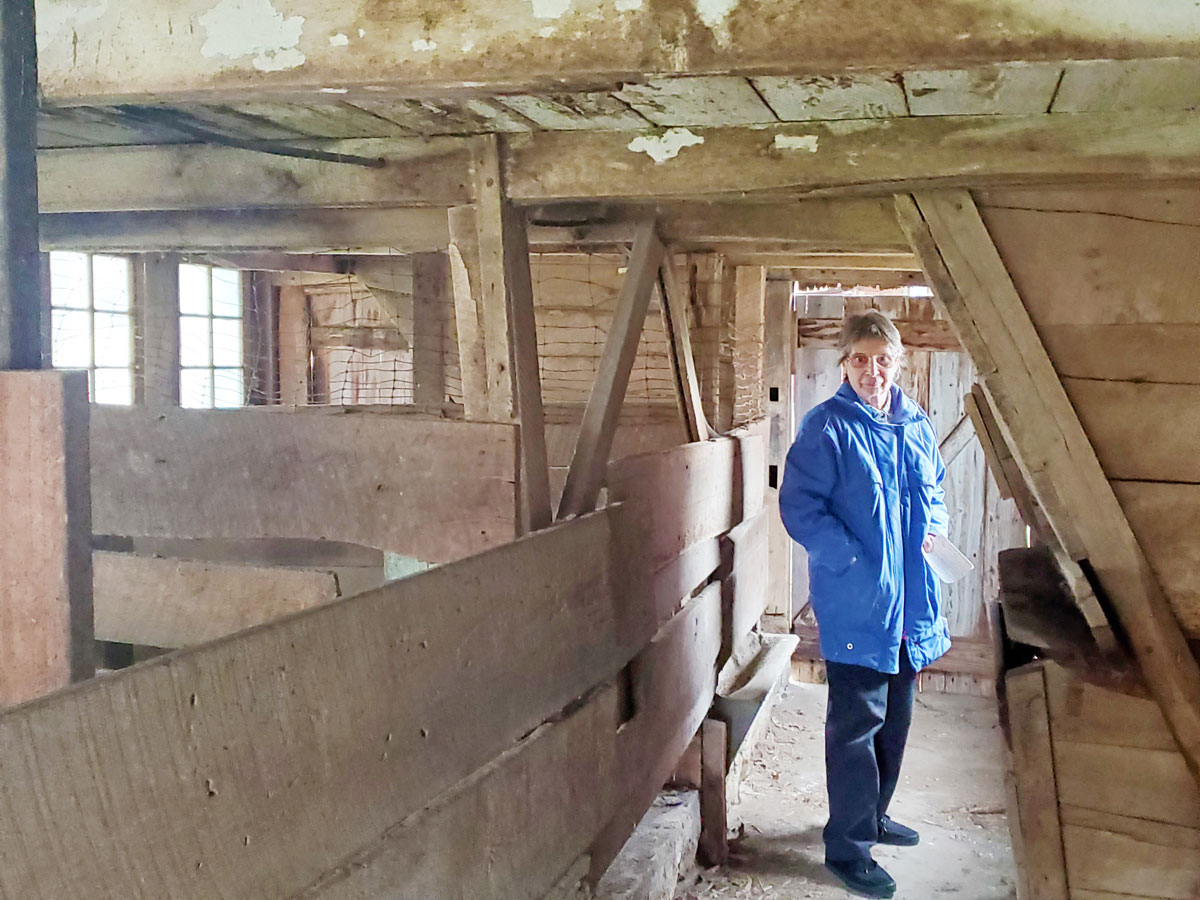
Viola (Zentz) Noffsinger is shown in the hog pens of her former family farm in Thurmont.
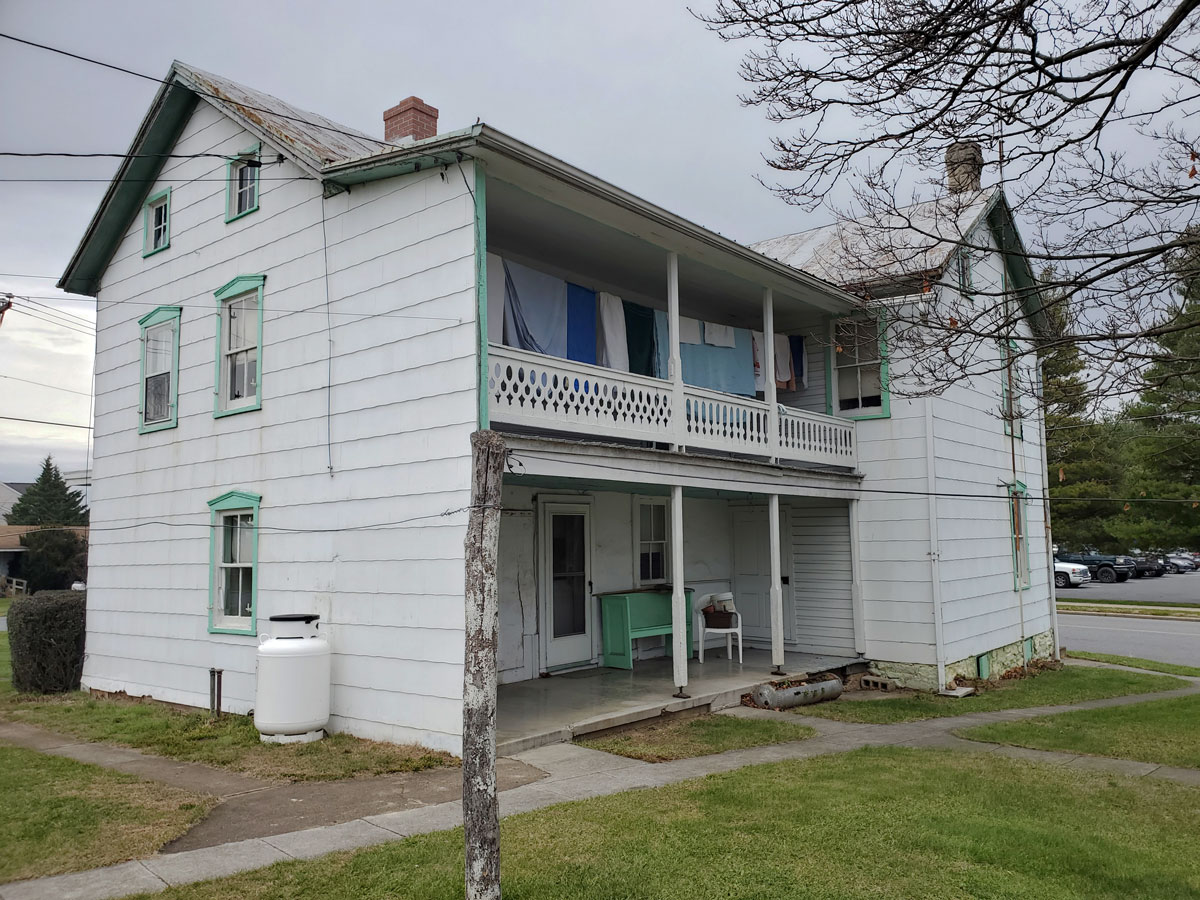
The back of the Zentz Farmhouse.
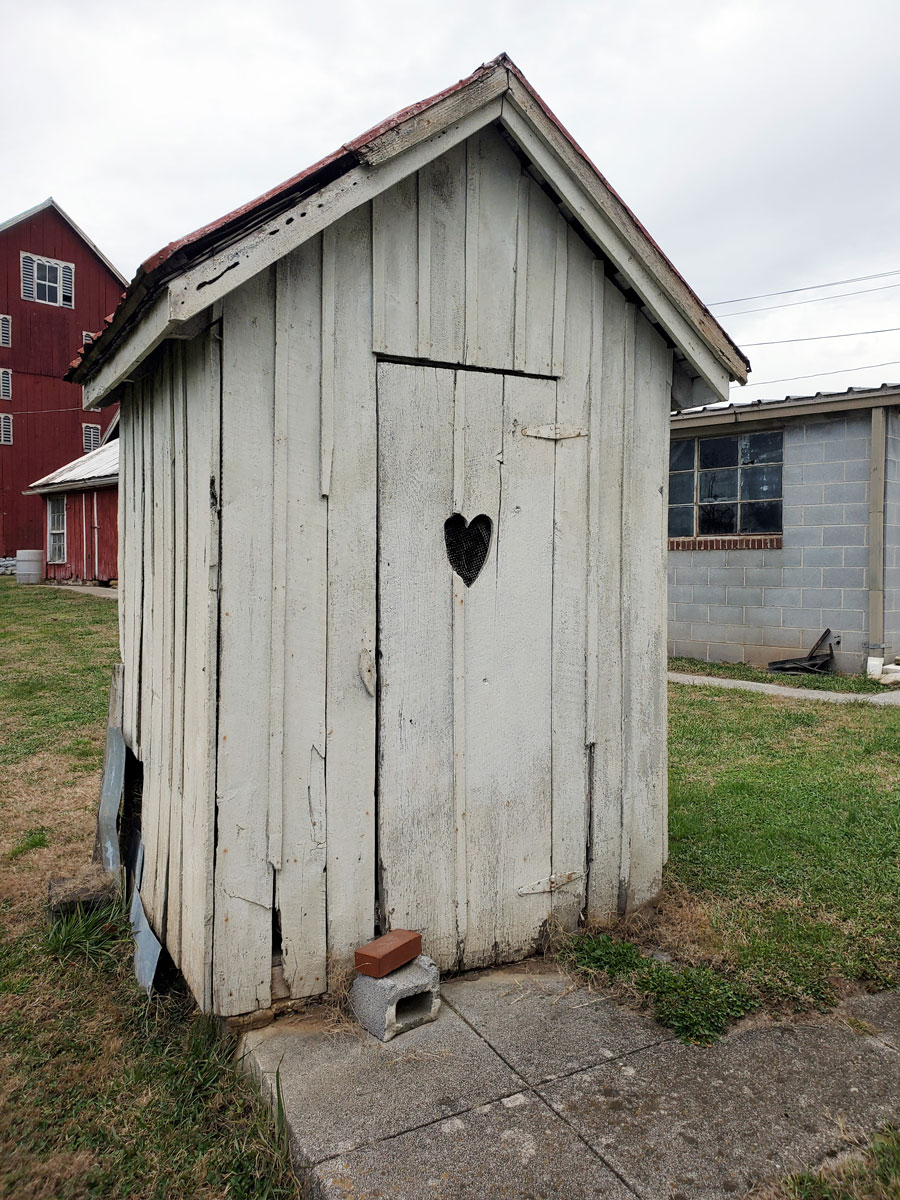
The outhouse, which was used before the farm got indoor plumbing.
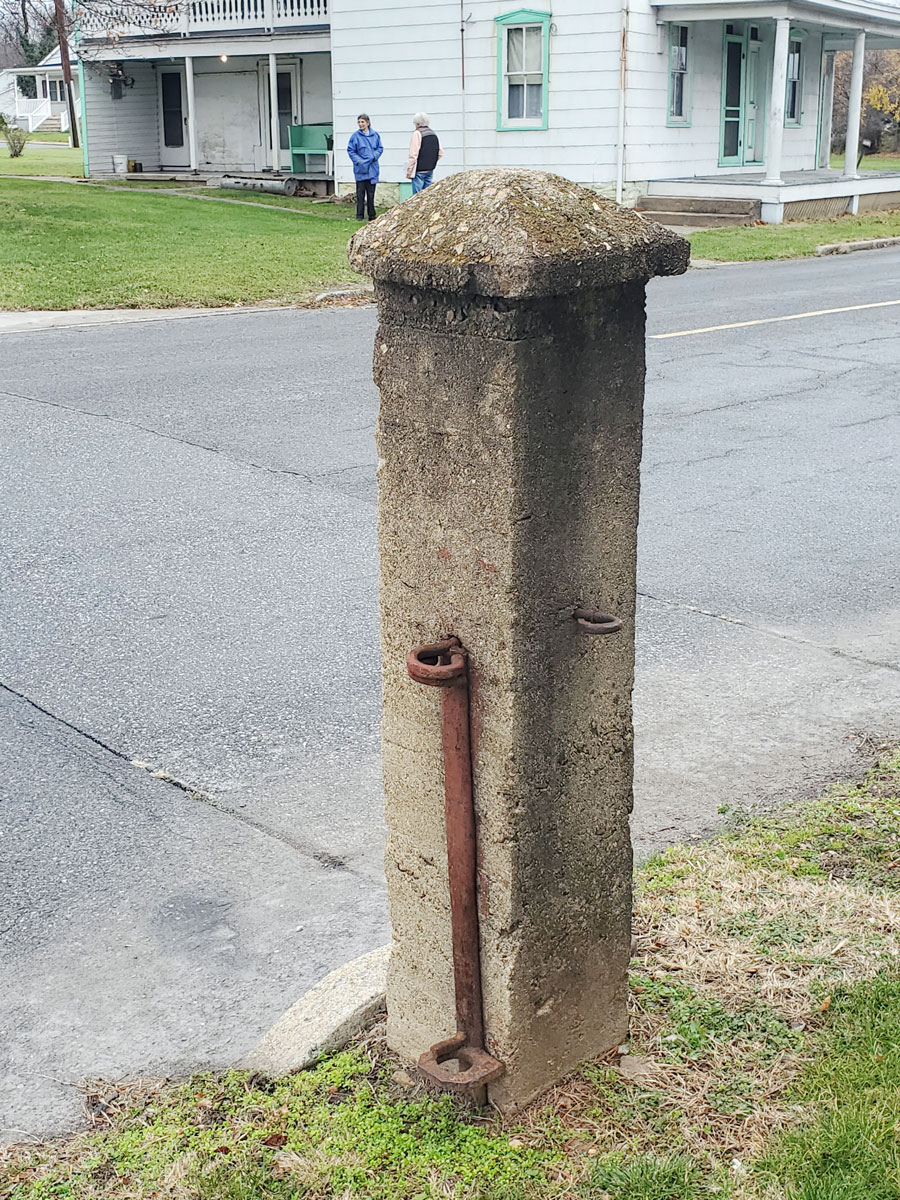
The old gate post that held three farm gates still stands across Apple’s Church Road from the farm.
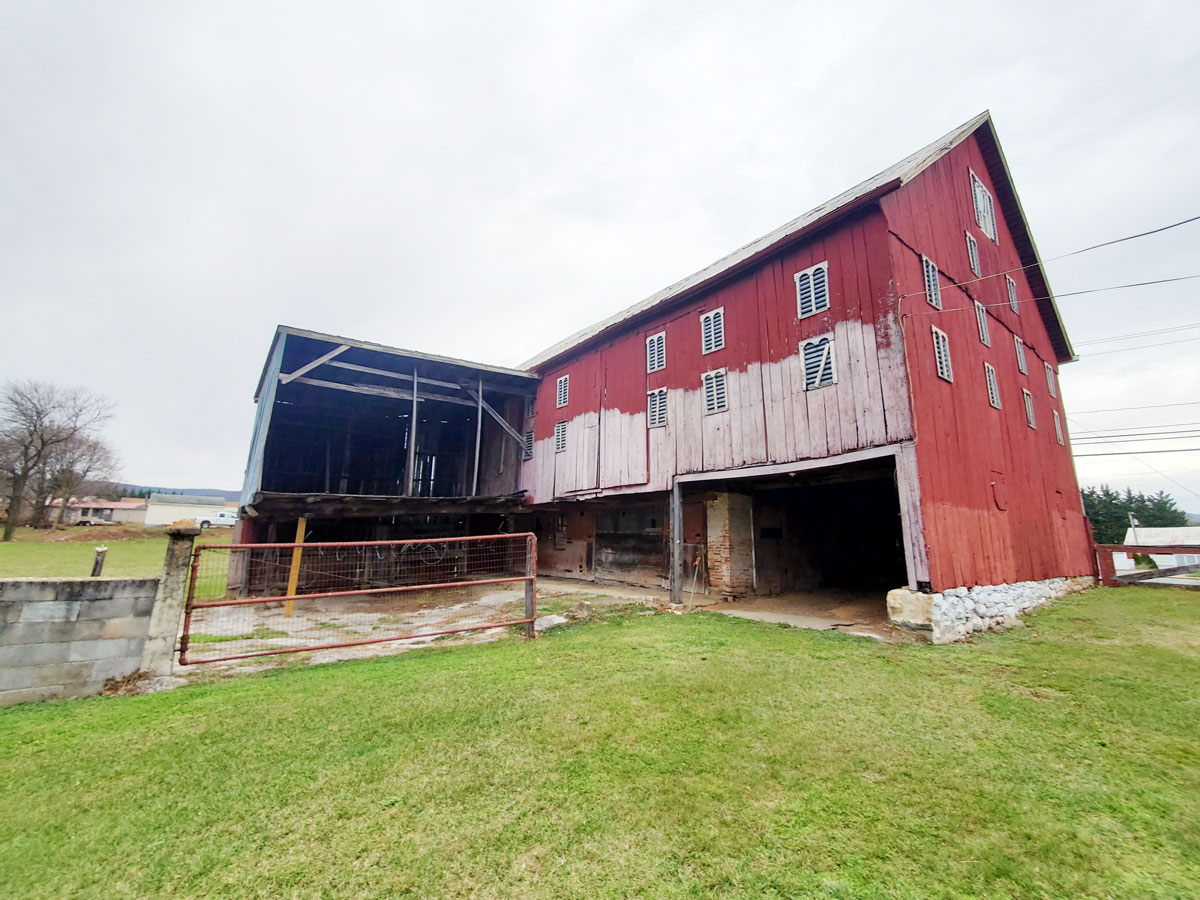
The lower barn on the Zentz Farm included a corn crib, wagon shed, and stables.

